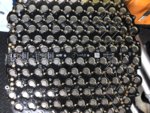Cyrus David
Active member
- Likes
- 26
- Location
- West palm beach
I’m working with Cody, a local guy who also has an Alta and may end up attempting some cell replacements on his batt soon (his bike is in my garage and has a pack fault which won’t allow above 50% charge).
If I make any headway i’ll Post about it. I’m not a software guy but have spotwelded lithium cells in the past with my home made spot welder.
If I make any headway i’ll Post about it. I’m not a software guy but have spotwelded lithium cells in the past with my home made spot welder.
I am sure you guys are aware, but I will post it anyway.
What you guys are planning to do is extremely dangerous without the proper equipment and training. Please be very careful.

